Vacuum Sealing Raw Meat: Essential Food Safety Guidelines
Proper vacuum sealing of raw meat stands as a critical defense against foodborne illness and quality degradation in home food storage. This preservation method extends beyond basic freezer burn prevention, creating an essential barrier that blocks bacterial growth and oxidation – two primary factors that compromise meat safety and quality. Scientific research confirms that airtight storage significantly reduces the risk of pathogenic bacteria proliferation while maintaining the meat's nutritional integrity.
Understanding the precise mechanics of vacuum sealing ensures optimal food safety outcomes. The process eliminates oxygen exposure, which not only prevents spoilage but also maintains the meat's original flavor profile and texture. Professional food safety experts emphasize that vacuum sealing, when combined with proper temperature control, can extend meat storage life by 3-5 times compared to conventional storage methods.
Key safety benefits include:
- Minimized bacterial growth potential
- Reduced cross-contamination risks
- Extended preservation of nutritional value
- Prevention of freezer burn damage
- Enhanced protection against environmental contaminants
Modern vacuum sealing technology, backed by food science research, has revolutionized home meat storage practices, making professional-grade preservation accessible to home cooks while supporting crucial food safety protocols.
Understanding Vacuum Sealing Benefits
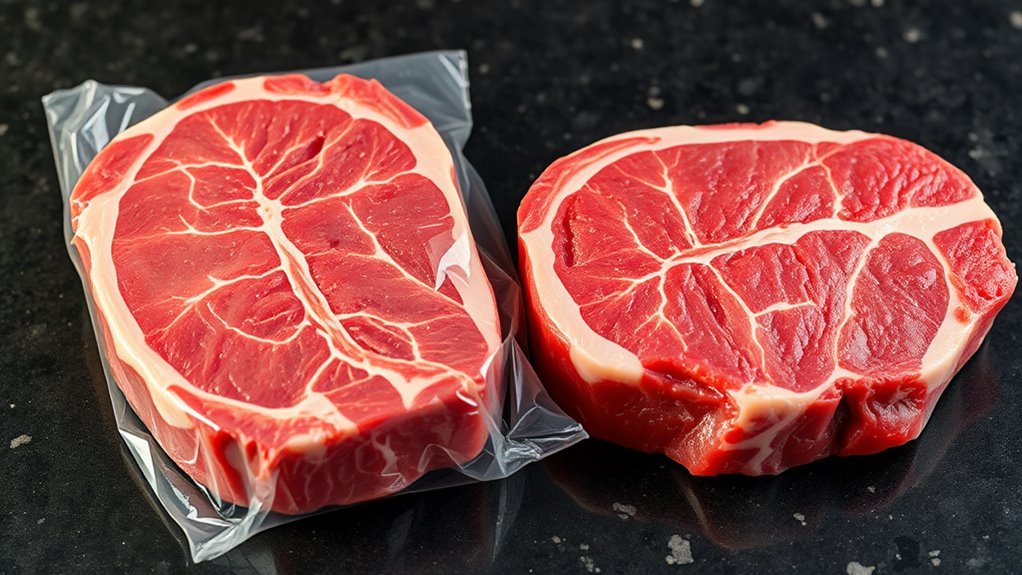
Three key advantages make vacuum sealing an essential preservation method for raw meat.
First, I'm excited to share that vacuum sealing dramatically extends the shelf life of food, keeping your meat fresh up to two weeks longer in the fridge and an impressive 6-12 months in the freezer. When you're busy with meal prep or taking advantage of bulk meat sales, this is a game-changer for your kitchen strategy.
I've discovered that the magic behind vacuum sealing lies in its ability to remove air, which is the enemy of fresh food. By creating an airtight environment, you're effectively stopping oxidation and slowing down those pesky bacteria that cause spoilage.
Your vacuum sealed meat stays tender, flavorful, and packed with nutrients – just the way you bought it.
What I love most about this food safety technique is how it prevents freezer burn, a common problem that ruins both the taste and texture of frozen meat. Additionally, vacuum sealing reduces the risk of contamination by protecting food from harmful bacteria and mold growth.
When you vacuum seal properly, using quality bags and ensuring a tight seal, you're not just preserving food – you're preserving quality and saving money by reducing waste.
Proper Storage Temperature Guidelines
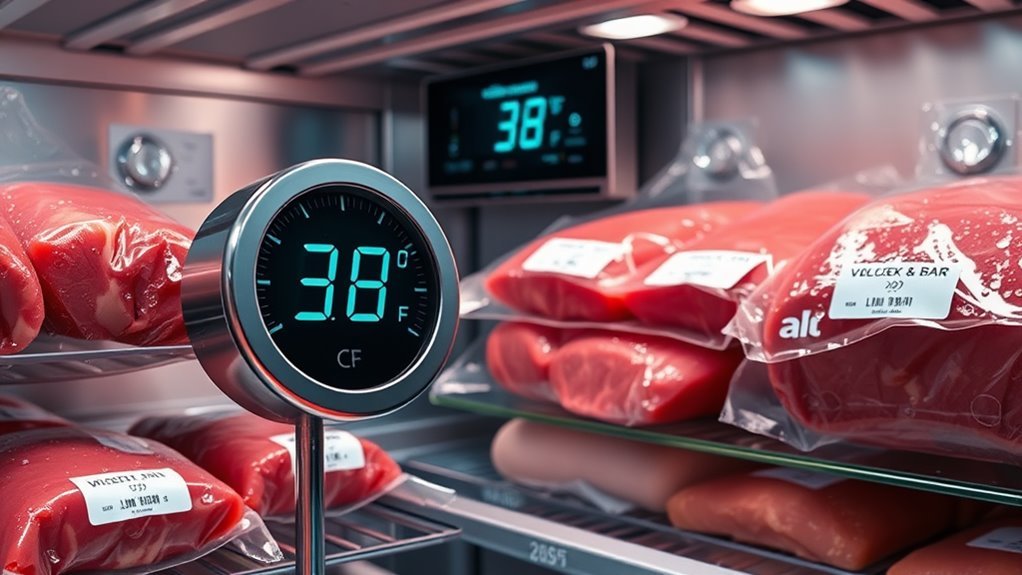
Your home refrigerator's temperature control acts as the guardian of food safety when storing vacuum-sealed raw meat. I can't stress enough how vital it's to maintain temperatures between 32°F and 40°F to keep your food fresh and safe.
When I'm working with vacuum-sealed meat, I make sure my fridge stays within this range by checking it regularly.
I've found that proper storage temperature is the key to maximizing the benefits of vacuum sealing. While traditional storage methods only keep raw meat fresh for 1-3 days, I'm able to extend that to two whole weeks with vacuum-sealed packages!
But here's the catch – you've got to keep that temperature steady. I recommend using a fridge thermometer to monitor any fluctuations that could compromise food safety.
Additionally, maintaining this temperature is crucial, as certain bacteria can thrive in low-oxygen environments created by vacuum sealing if food is not stored properly.
Let me share a pro tip: if you won't be using your vacuum-sealed meat within two weeks, pop it in the freezer right after sealing. I've successfully stored meat this way for up to a year without sacrificing quality.
Just remember, never leave raw meat in the danger zone (40°F-140°F) for more than two hours, or you'll risk spoilage and foodborne illness.
Essential Equipment and Supplies
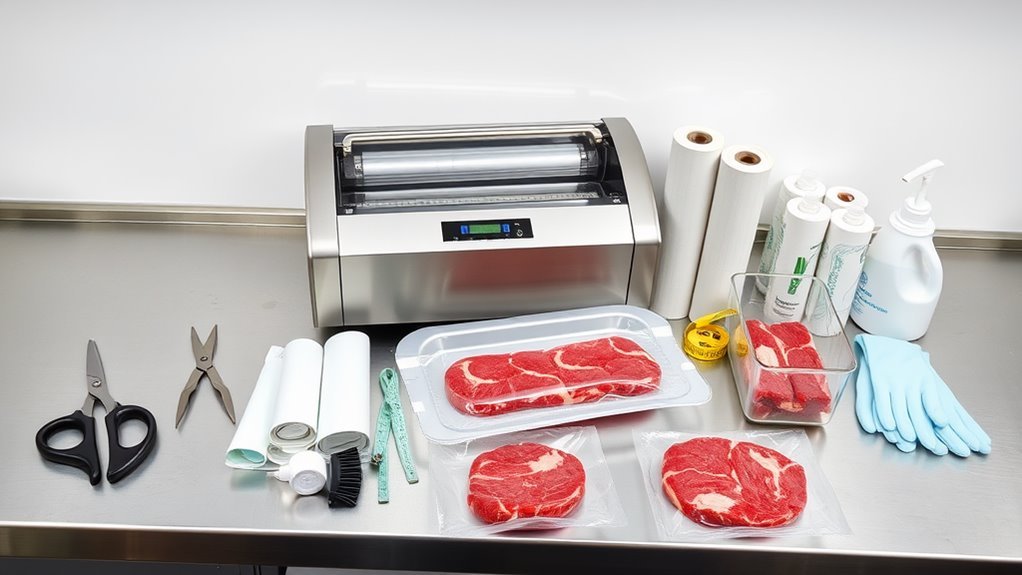
Now that you've got your storage temperatures dialed in, let's focus on the equipment that makes vacuum sealing possible.
I'll guide you through selecting the perfect vacuum sealer and essential supplies you'll need for safe food preservation of raw meat.
First, you'll want to invest in a reliable vacuum sealer that offers adjustable pressure settings.
I've found that having control over the vacuum strength is vital – you don't want to crush your delicate items, but you need enough power to create that all-important airtight seal.
For maximum food safety, I recommend choosing a model with clear pressure indicators and easy-to-clean surfaces.
Don't skimp on those vacuum seal bags!
I always stress the importance of using high-quality bags specifically designed for food preservation.
They're stronger, more puncture-resistant, and guarantee your raw meat stays properly sealed.
Additionally, utilizing vacuum sealing can significantly reduce food waste by promoting smarter meal planning and consumption before spoilage.
I also suggest picking up some handy accessories like vacuum canisters for marinades and a cleaning kit to maintain your equipment.
Safe Handling Procedures
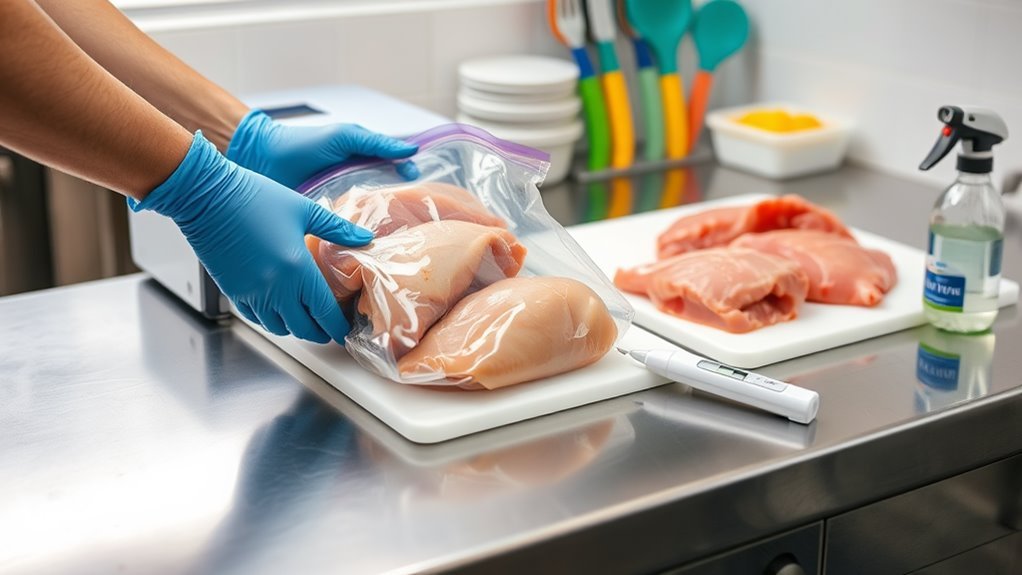
Safe handling of raw meat requires meticulous attention to prevent foodborne illness when vacuum sealing. I'm passionate about reducing the risk of contamination while helping you maximize your food's shelf life and minimize food waste.
Let me walk you through the essential steps that'll keep you and your family safe when preparing meat for vacuum packing.
Here's what you need to do:
- Start with impeccably clean hands, workspace, and tools – I can't stress enough how vital this is for preventing cross-contamination between raw meats and other surfaces.
- Keep your meat refrigerated at 32-40°F until you're ready to vacuum seal, and work quickly to minimize time in the danger zone.
- Use only high-quality vacuum seal bags designed specifically for meat storage – this isn't the place to cut corners.
- Label everything clearly with the date and type of meat – I've learned this simple step makes a huge difference in tracking storage times.
Additionally, improper vacuum sealing can lead to promotion of harmful bacteria growth, which is a significant risk when storing raw meat.
Remember to check your vacuum packed containers regularly for seal integrity. If you spot any leaks or signs of spoilage, don't take chances – it's better to discard the meat than risk getting sick.
Common Risks and Prevention
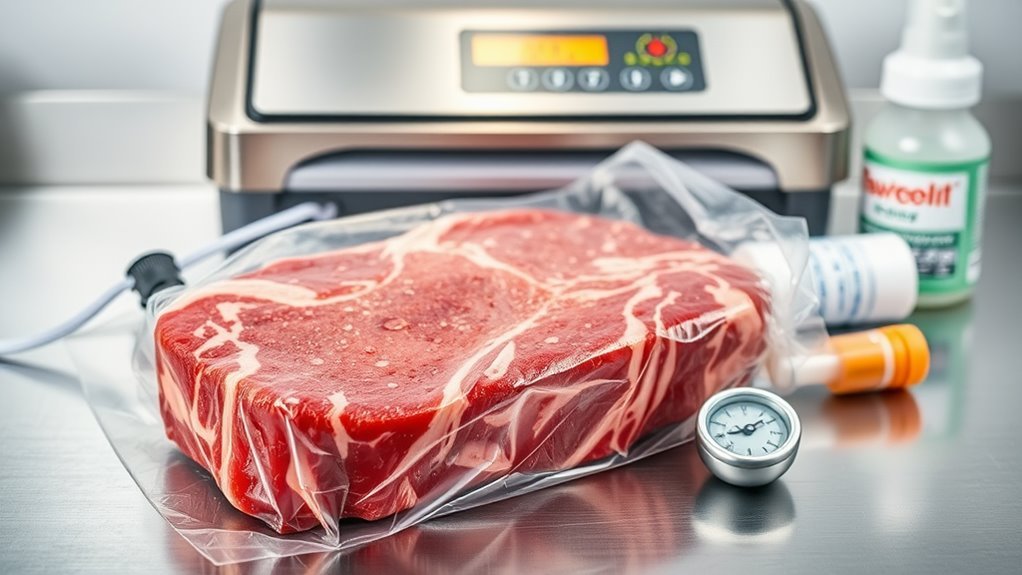
While vacuum sealing offers excellent preservation benefits, it creates specific risks that I want you to understand and prevent. I'm particularly concerned about Clostridium botulinum, a dangerous bacteria that thrives in low-oxygen environments. When you vacuum seal raw meat, you're creating the perfect conditions for these bacteria if proper precautions aren't taken.
| Risk Factor | Potential Outcome | Prevention Strategy |
|---|---|---|
| Improper Temperature | Bacterial Growth | Maintain 32-40°F storage |
| Contaminated Tools | Foodborne Illness | Clean all equipment thoroughly |
| Anaerobic Environment | Botulism Risk | Monitor storage time limits |
Let me share some vital prevention tips that'll keep you safe. Never vacuum seal fresh garlic or raw onions with your meat, as they can harbor harmful spores. When you're thawing sealed fish, always remove it from the packaging first to expose it to oxygen. I've found that consistent temperature monitoring is your best defense against bacterial growth. Additionally, adhering to proper vacuum sealing techniques can further enhance food safety by limiting microbial activity. By following these guidelines and regularly checking for signs of spoilage, you'll greatly reduce your risk of foodborne illness while enjoying the benefits of vacuum sealing.
Extending Meat Shelf Life
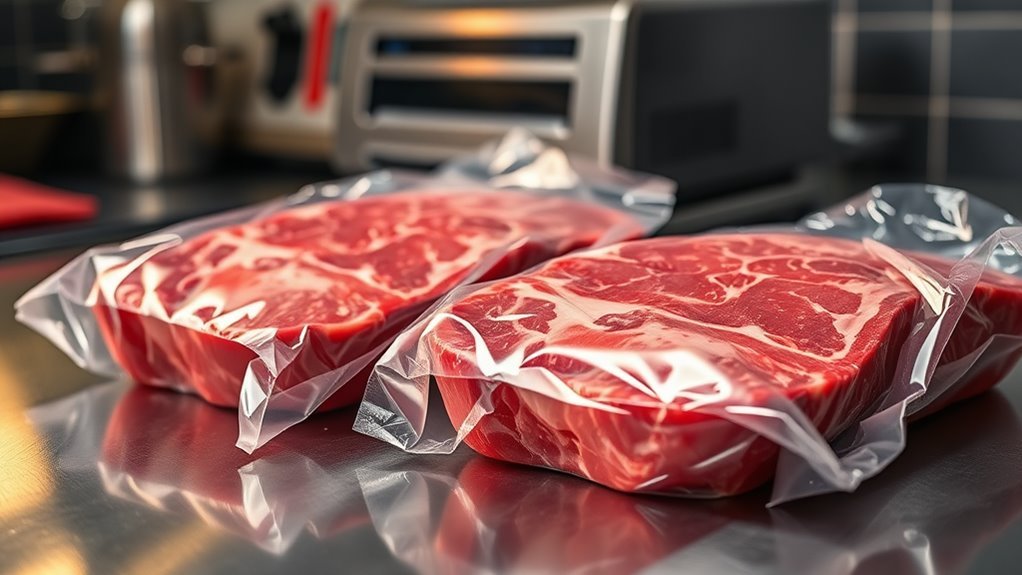
Building on our safety practices, let's explore how vacuum sealing dramatically extends your meat's shelf life. I'm excited to share how this innovative technology transforms the way we store meat products, keeping them fresher and safer for longer periods.
When you vacuum seal your raw meat, you're taking advantage of a proven method that delivers impressive results. Here's what you can expect:
- Your refrigerated meat stays fresh for up to 2 weeks instead of just 1-2 days, giving you more flexibility in meal planning.
- Frozen meat maintains its quality for 6-12 months, doubling or tripling the typical storage time.
- The absence of oxygen preserves flavor, texture, and nutrients by preventing oxidation.
- You'll say goodbye to freezer burn, which can ruin meat in just a few weeks.
I've found that extending the shelf life through vacuum sealing isn't just about convenience – it's a game-changer for food safety too. Properly vacuum-sealed meat not only prevents oxidation but also minimizes the risk of bacterial growth.
Packaging Best Practices
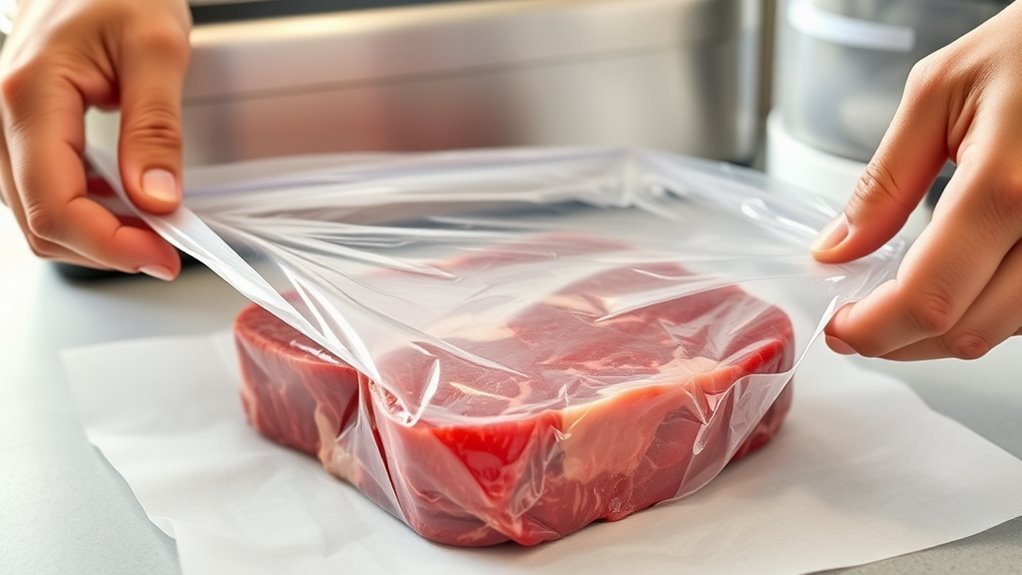
From the moment you begin vacuum sealing raw meat, following proper packaging practices becomes essential for food safety success.
I've found that using high-quality, food-grade plastic bags specifically designed for meat storage makes all the difference in preventing contamination and spoilage. When I'm handling raw chicken or other meats, I always make sure they're properly chilled between 32°F and 40°F before sealing.
One of the key benefits of vacuum sealing is extended shelf life, but you'll only achieve this by following vital steps. I always pat my food dry before packaging since excess moisture can compromise the seal and create a breeding ground for bacteria. Additionally, vacuum sealing deli meat can extend its freshness up to six months compared to non-sealed storage.
Here's a pro tip: Label everything! I write the date and type of meat on each package, which helps me track storage times – one to two weeks in the fridge or up to a year in the freezer.
Don't forget to regularly check your sealed packages for any signs of damage or spoilage. If you notice off-colors or strange smells when you open a package, it's better to be safe and toss it out.
Your family's health is worth the extra attention to detail!
Vacuum Sealing Safety Standards
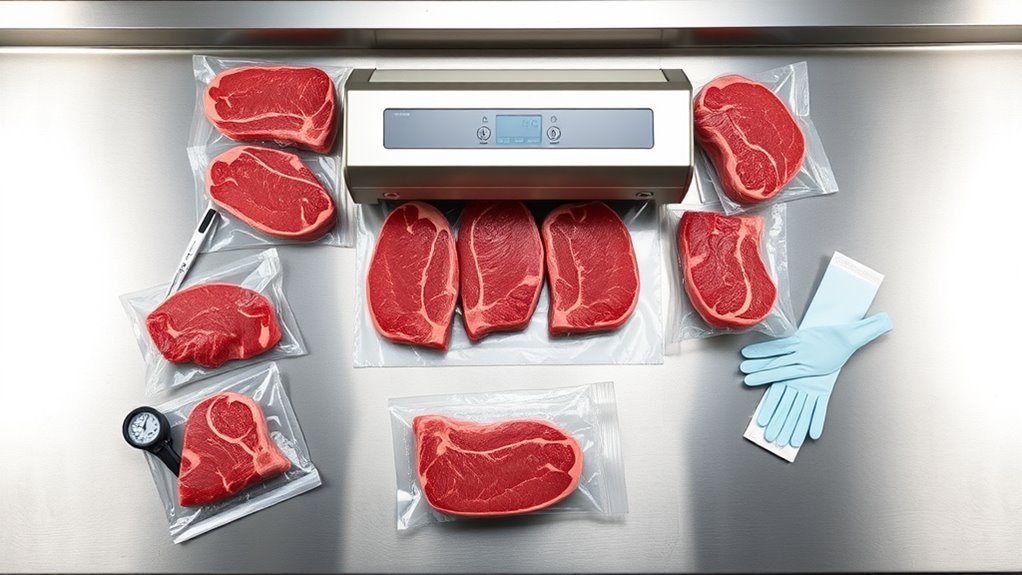
Vacuum Sealing Safety Standards
Safety standards for vacuum sealing raw meat go beyond basic packaging practices.
I'm passionate about helping you understand the vital safety measures needed to prevent foodborne illness when using this innovative preservation method. Let me share the essential standards you'll need to follow for peak food safety.
Here are the key safety protocols I recommend:
- Monitor refrigeration temperatures religiously, keeping them between 32°F and 40°F to inhibit bacterial growth.
- Check vacuum seals thoroughly before storage to prevent compromised packaging that could lead to contamination.
- Follow HACCP guidelines meticulously, especially if you're in California where they're mandatory.
- Watch for signs of spoilage or excess moisture before sealing, as these conditions can promote dangerous anaerobic bacteria.
I can't stress enough how important it's to understand that vacuum sealing doesn't kill bacteria – it only creates an environment that can either help preserve your meat safely or, if done incorrectly, promote harmful bacterial growth. Additionally, proper sealing techniques help prevent bacterial growth and ensure your meat remains fresh for longer periods.
Conclusion
I'm convinced that vacuum sealing raw meat isn't just some newfangled gadget trend – it's a game-changer for food safety in your kitchen. Like a medieval castle's protective moat, it creates an impenetrable barrier against bacteria and oxidation. I've seen firsthand how it extends shelf life, prevents freezer burn, and keeps meat fresh longer. By following proper techniques and safety guidelines, you'll protect your family while saving money and reducing waste.
